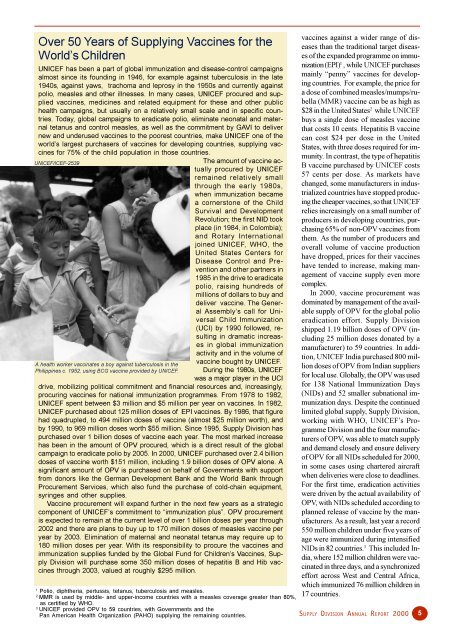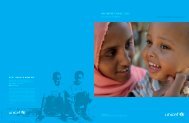Medical supplies and equipment - Unicef
Medical supplies and equipment - Unicef
Medical supplies and equipment - Unicef
You also want an ePaper? Increase the reach of your titles
YUMPU automatically turns print PDFs into web optimized ePapers that Google loves.
Over 50 Years of Supplying Vaccines for the<br />
World’s Children<br />
UNICEF has been a part of global immunization <strong>and</strong> disease-control campaigns<br />
almost since its founding in 1946, for example against tuberculosis in the late<br />
1940s, against yaws, trachoma <strong>and</strong> leprosy in the 1950s <strong>and</strong> currently against<br />
polio, measles <strong>and</strong> other illnesses. In many cases, UNICEF procured <strong>and</strong> supplied<br />
vaccines, medicines <strong>and</strong> related <strong>equipment</strong> for these <strong>and</strong> other public<br />
health campaigns, but usually on a relatively small scale <strong>and</strong> in specific countries.<br />
Today, global campaigns to eradicate polio, eliminate neonatal <strong>and</strong> maternal<br />
tetanus <strong>and</strong> control measles, as well as the commitment by GAVI to deliver<br />
new <strong>and</strong> underused vaccines to the poorest countries, make UNICEF one of the<br />
world’s largest purchasers of vaccines for developing countries, supplying vaccines<br />
for 75% of the child population in those countries.<br />
UNICEF/ICEF-2539<br />
The amount of vaccine actually<br />
procured by UNICEF<br />
remained relatively small<br />
through the early 1980s,<br />
when immunization became<br />
a cornerstone of the Child<br />
Survival <strong>and</strong> Development<br />
Revolution; the first NID took<br />
place (in 1984, in Colombia);<br />
<strong>and</strong> Rotary International<br />
joined UNICEF, WHO, the<br />
United States Centers for<br />
Disease Control <strong>and</strong> Prevention<br />
<strong>and</strong> other partners in<br />
1985 in the drive to eradicate<br />
polio, raising hundreds of<br />
millions of dollars to buy <strong>and</strong><br />
deliver vaccine. The General<br />
Assembly’s call for Universal<br />
Child Immunization<br />
(UCI) by 1990 followed, resulting<br />
in dramatic increases<br />
in global immunization<br />
activity <strong>and</strong> in the volume of<br />
A health worker vaccinates a boy against tuberculosis in the vaccine bought by UNICEF.<br />
Philippines c. 1952, using BCG vaccine provided by UNICEF. During the 1980s, UNICEF<br />
was a major player in the UCI<br />
drive, mobilizing political commitment <strong>and</strong> financial resources <strong>and</strong>, increasingly,<br />
procuring vaccines for national immunization programmes. From 1978 to 1982,<br />
UNICEF spent between $3 million <strong>and</strong> $5 million per year on vaccines. In 1982,<br />
UNICEF purchased about 125 million doses of EPI vaccines. By 1986, that figure<br />
had quadrupled, to 494 million doses of vaccine (almost $25 million worth), <strong>and</strong><br />
by 1990, to 969 million doses worth $55 million. Since 1995, Supply Division has<br />
purchased over 1 billion doses of vaccine each year. The most marked increase<br />
has been in the amount of OPV procured, which is a direct result of the global<br />
campaign to eradicate polio by 2005. In 2000, UNICEF purchased over 2.4 billion<br />
doses of vaccine worth $151 million, including 1.9 billion doses of OPV alone. A<br />
significant amount of OPV is purchased on behalf of Governments with support<br />
from donors like the German Development Bank <strong>and</strong> the World Bank through<br />
Procurement Services, which also fund the purchase of cold-chain <strong>equipment</strong>,<br />
syringes <strong>and</strong> other <strong>supplies</strong>.<br />
Vaccine procurement will exp<strong>and</strong> further in the next few years as a strategic<br />
component of UNICEF’s commitment to “immunization plus”. OPV procurement<br />
is expected to remain at the current level of over 1 billion doses per year through<br />
2002 <strong>and</strong> there are plans to buy up to 170 million doses of measles vaccine per<br />
year by 2003. Elimination of maternal <strong>and</strong> neonatal tetanus may require up to<br />
180 million doses per year. With its responsibility to procure the vaccines <strong>and</strong><br />
immunization <strong>supplies</strong> funded by the Global Fund for Children’s Vaccines, Supply<br />
Division will purchase some 350 million doses of hepatitis B <strong>and</strong> Hib vaccines<br />
through 2003, valued at roughly $295 million.<br />
1 Polio, diphtheria, pertussis, tetanus, tuberculosis <strong>and</strong> measles.<br />
2 MMR is used by middle- <strong>and</strong> upper-income countries with a measles coverage greater than 80%,<br />
as certified by WHO.<br />
3 UNICEF provided OPV to 59 countries, with Governments <strong>and</strong> the<br />
Pan American Health Organization (PAHO) supplying the remaining countries.<br />
vaccines against a wider range of diseases<br />
than the traditional target diseases<br />
of the exp<strong>and</strong>ed programme on immunization<br />
(EPI) 1 , while UNICEF purchases<br />
mainly “penny” vaccines for developing<br />
countries. For example, the price for<br />
a dose of combined measles/mumps/rubella<br />
(MMR) vaccine can be as high as<br />
$28 in the United States 2 while UNICEF<br />
buys a single dose of measles vaccine<br />
that costs 10 cents. Hepatitis B vaccine<br />
can cost $24 per dose in the United<br />
States, with three doses required for immunity.<br />
In contrast, the type of hepatitis<br />
B vaccine purchased by UNICEF costs<br />
57 cents per dose. As markets have<br />
changed, some manufacturers in industrialized<br />
countries have stopped producing<br />
the cheaper vaccines, so that UNICEF<br />
relies increasingly on a small number of<br />
producers in developing countries, purchasing<br />
65% of non-OPV vaccines from<br />
them. As the number of producers <strong>and</strong><br />
overall volume of vaccine production<br />
have dropped, prices for their vaccines<br />
have tended to increase, making management<br />
of vaccine supply even more<br />
complex.<br />
In 2000, vaccine procurement was<br />
dominated by management of the available<br />
supply of OPV for the global polio<br />
eradication effort. Supply Division<br />
shipped 1.19 billion doses of OPV (including<br />
25 million doses donated by a<br />
manufacturer) to 59 countries. In addition,<br />
UNICEF India purchased 800 million<br />
doses of OPV from Indian suppliers<br />
for local use. Globally, the OPV was used<br />
for 138 National Immunization Days<br />
(NIDs) <strong>and</strong> 52 smaller subnational immunization<br />
days. Despite the continued<br />
limited global supply, Supply Division,<br />
working with WHO, UNICEF’s Programme<br />
Division <strong>and</strong> the four manufacturers<br />
of OPV, was able to match supply<br />
<strong>and</strong> dem<strong>and</strong> closely <strong>and</strong> ensure delivery<br />
of OPV for all NIDs scheduled for 2000,<br />
in some cases using chartered aircraft<br />
when deliveries were close to deadlines.<br />
For the first time, eradication activities<br />
were driven by the actual availability of<br />
OPV, with NIDs scheduled according to<br />
planned release of vaccine by the manufacturers.<br />
As a result, last year a record<br />
550 million children under five years of<br />
age were immunized during intensified<br />
NIDs in 82 countries. 3 This included India,<br />
where 152 million children were vaccinated<br />
in three days, <strong>and</strong> a synchronized<br />
effort across West <strong>and</strong> Central Africa,<br />
which immunized 76 million children in<br />
17 countries.<br />
SUPPLY DIVISION ANNUAL REPORT 2000 5





